#CAC Brétigny
Text
Vous connaissez l'artiste peintre français Ibrahim Meïté Sikely (FR)
Ibrahim Meïté SikelyTête d’étoile, 2021huile sur toile / oil on canvas150 x 70 cm
Né en 1996, Ibrahim Meïté Sikely vit et travaille à Champigny-sur-Marne et Paris. Il a obtenu son DNSEP à la Villa Arson à Nice en 2022 et est actuellement étudiant à l’Ecole nationale supérieure des Beaux-Arts de Paris.
Il a récemment participé à plusieurs expositions au CAC Brétigny, au FRAC Lorraine, Metz, au…

View On WordPress
#51 rue des archives#au FRAC Lorraine#CAC Brétigny#Ecole nationale supérieure des Beaux-Arts de Paris#galerie anne barrault#galerie Project Native Informant#Ibrahim Meïté Sikely#Metz#Overthinkingman#Palais de Tokyo#Paris#Paumé arts et littératures#Salon de Montrouge#Tête d’étoile#The Five Marvelous Neighbors from the 5th Floor#Vous connaissez l&039;artiste peintre français Ibrahim Meïté Sikely (FR)#www.galerieannebarrault.com
0 notes
Text
youtube
Deciphering Social Dissonance: Ideology, Noise, and Subjectivity, Session 1
Session 2 HERE
During this workshop, we will try to decipher social dissonance and why it happens.
For the philosopher and essayist Sylvia Wynter, deciphering is a practice that tries to answer these questions: What does aesthetics do? What is its function in human life? What, specifically, is its function in our present "form of life"? Deciphering It is not a process of demystification, instead, it tries to understand what mystification does, and how it is complicit in reproducing the privileges of certain subjects through a problematic understanding of autonomy.
Deciphering breaks with disciplinary divisions, and it engages with natural sciences as well as discursive production as a way to get the broadest perspective possible in regard to what we mean to be a human.
Social dissonance takes Leon’s Festigner idea of cognitive dissonance as a starting point. Cognitive describes the tension when somebody has two contradictory sets of cognitions, or when your actions don’t match your beliefs. Social dissonance is, then, a structural cognitive dissonance that emerges from the discrepancy between the values that are shared in liberal Western democracies--such as the belief in individual freedom, democracy, equality, and sustainability--and what we really do, which is to reproduce a system based on inequality, exploitation, unfreedom and the destruction of the planet through extraction. Festinger suggests that we constantly try to reduce the dissonant elements by making justifications and excuses.
What can be the justifications for social dissonance? My answer to this is twofold, one structural and one subjective. The first justification has to do with what Mark Fisher called capitalist realism: as there is no alternative to the capitalist mode of production, we cannot think of an alternative to Western democracy and the liberal idea of the individual. Since there does not seem to be a possibility of another form of life outside the capitalist mode of production, we accept the limited freedoms that are offered to us.
The second justification has to do with conflating the ideas of individuality and selfhood with subjectivity. We tend to think that what we understand by individual freedom is already subjective agency.
During this workshop, we will look at current research made in neuroscience such as predictive processing (PP) in relation to discussions around social synthesis, ideology, mental state of noise, and cultural hegemony. By doing this, we will attempt to decipher the function of social dissonance in the current form of life.
About the Author:
Mattin is an artist, musician, and theorist working conceptually with noise and improvisation. Through his practice and writing, he explores performative forms of estrangement as a way to deal with structural alienation. Mattin has exhibited and toured worldwide. He has performed in festivals such as Performa (NYC), No Fun (NYC), Club Transmediale (Berlin), Arika (Glasgow) and lectured and taught in institutions such as Dutch Art Institute, Cal Arts, Bard College, Paris VIII, Princeton University and Goldsmiths College. In 2017 he completed a PhD at the University of the Basque Country under the supervision of the philosopher Ray Brassier. Along with Anthony Iles, he edited the book Noise & Capitalism (Kritika/Arteleku 2009). In 2012 CAC Brétigny and Tuamaturgia published Unconsitituted Praxis, a book collecting his writing plus interviews and reviews from performances. Anthony Iles and Mattin are currently in the final stages of editing the volume Abolishing Capitalist Totality: What is To Be Done Under Real Subsumption? (Archive Books). Urbanomic published last year his book Social Dissonance. Mattin is part of the bands Billy Bao and Regler and has over 100 releases on different labels worldwide. He is currently co-hosting with Miguel Prado the podcast Social Discipline. Prado and Mattin are also part of Noise Research Union with Cecile Malaspine, Sonia de Jager, Martina Raponi, and Inigo Wilkins. Mattin took part in 2017 in documenta14 in Athens and Kassel.
------
This lecture covers the same ground as the book he released last year, Social Dissonance. It's like $13 via amazon on paperback and kindle, but also might be available on libgen, who could say.
2 notes
·
View notes
Photo

VALENTINE SCHLEGEL & IRIS MURDOCH
En las Leyes, un tratado que describe una sociedad completamente estable, Platón le hace al arte el cumplido (y es un cumplido) que este recibe actualmente en la Europa del Este. Los usos didácticos del arte se escrutan minuciosamente; incluso los juegos de niños han de estar bajo control (797 b). La música y la canción tienen que ser santificadas y volverse inmutables, como en el Egipto de hace diez mil años (657, 799), cuyas pinturas y esculturas no son ni mejores ni peores que las de hoy. El ciudadano más importante del Estado será el ministro de Educación (765 d). Las Musas y los dioses de los juegos ayudarán con el miedo, la ley y la disputa (783 a), y la ciudadanía será «compelida a cantar de buen grado, por así decirlo» (670 d). La gente debe ser educada desde edad temprana para gozar solo de los placeres buenos, y los poetas serán conminados a explicar que el hombre justo es feliz siempre (659 d, 660 e). El mejor paradigma literario al que puede recurrir un escritor (esto tiene una resonancia kafkiana) es el mismo libro de las Leyes (957 d). Las Leyes demuestra lo muy seriamente que Platón se tomó el poder del arte, pero añade poco de interés filosófico relevante.
- Iris Murdoch, El fuego y el sol Por qué Platón desterró a los artistas. Basado en la Romanes Lecture de 1976. Traducción de Juan José Herrera de la Muela
- Camas de Valentine Schlegal (via CAC Brétigny)
4 notes
·
View notes
Text




Matthieu SALADIN
"Pile ou Face"
(7". CAC Brétigny. 2013) [FR]
2 notes
·
View notes
Photo
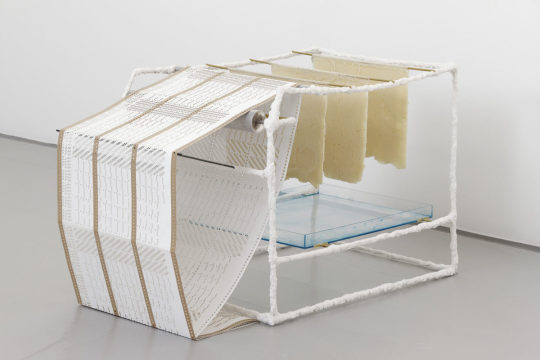

Xavier Antin
(in collaboration with Julien Jassaud and Camille Pageard)
‘The Weavers’ @ CAC Brétigny
46 notes
·
View notes
Photo

Esther Ferrer, Concierto Zaj para 30 ó 60 voces, (CD + poster), in collaboration with CAC Brétigny, «w.m.o/r» 37, W.M.O./r, 2012 [Fondazione Bonotto, Molvena (VI)]. Design by Vier5
#graphic design#typography#art#poetry#sound poetry#exhibition#cd#cover#esther ferrer#cac brétigny#w.m.o. r#vier5
8 notes
·
View notes
Photo
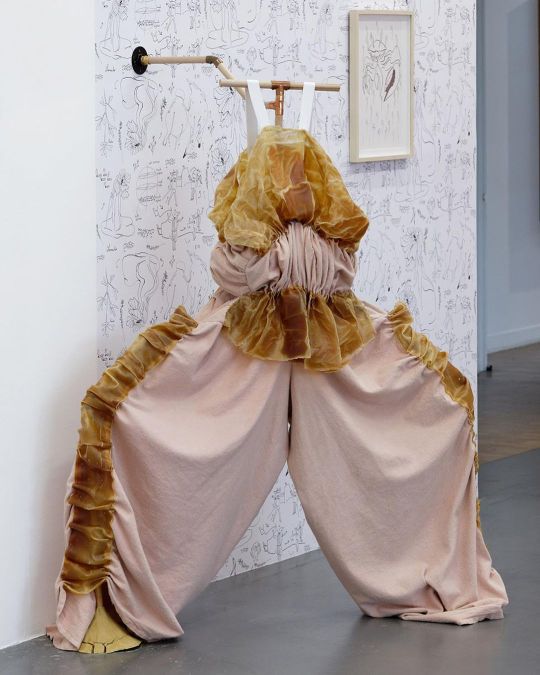
Bestiario de Lengüitas — Mercedes Azpilicueta at CAC Brétigny, Brétigny-sur-Orge, France Curated by Virginie Bobin Running until April, 24, 2021 @mercedes.azpilicueta @cacbretigny 🔗in stories #MercedesAzpilicueta #cacbretigny #cacbretignysurorge #bretignysurorge #bretignysurorgeexhibitions #Virginie Bobin #soloshow #soloexhibition #sculpture #drawing #installation #art #contemporaryart #ofluxo #ofluxopatform @ofluxoplatform (em Brétigny-sur-Orge) https://www.instagram.com/p/CMPQTNNlHQ5/?igshid=ounpfbfcef12
#mercedesazpilicueta#cacbretigny#cacbretignysurorge#bretignysurorge#bretignysurorgeexhibitions#virginie#soloshow#soloexhibition#sculpture#drawing#installation#art#contemporaryart#ofluxo#ofluxopatform
41 notes
·
View notes
Photo
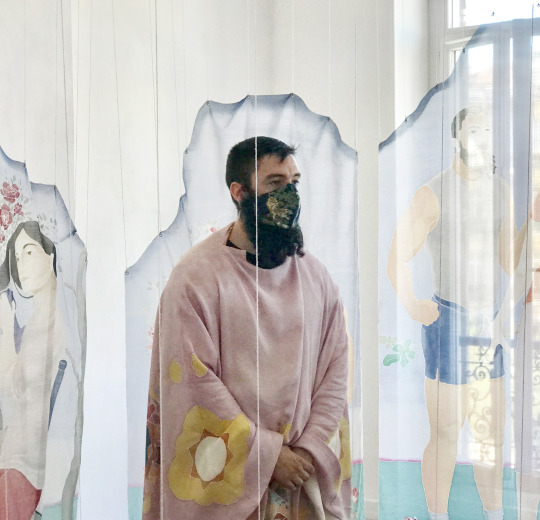
FR
Arthur Gillet
Arthur Gillet est né en 1986 à Rennes. Il y étudie à l’École des Beaux-arts, et suit les ateliers de danse contemporaine du Musée de la Danse et du Triangle. Il participe au salon du mobilier de Milan. Ayant obtenu son diplôme, et après un long pèlerinage en Italie, il s’établit à Paris en 2012 où il expose et performe au CAC de Brétigny, au MAC VAL, au Musée d’Art Moderne de Paris, au Palais de Tokyo et au Musée d’Orsay. Il collabore avec Cassina, François Chaignaud & Cécilia Bengolea, John Mayburry et Louis-Phillipe Scoufaras. En 2015, il gagne le prix du jeune talent à la foire internationale de design de Paris, Maison & Objet.
La surdité de ses parents ouvriers et sa jeunesse au féminin déplacent sa sensibilité sur les questions de l’identité, du désir, et de la perception du réel. Cela l’amène à jouer avec son corps comme projet plastique, comme outil de production et de diffusion, mais aussi comme sujet en quête d’émancipation. Il trouble les genres en infiltrant tour à tour la nuit, la mode, l’art, l’érotisme. Son rôle de modèle et d’artiste tout à la fois soulève une ambiguïté entre le passif et l’actif, où les hiérarchies sociales font écho aux hiérarchies sexuelles.
Arthur Gillet produit aussi des objets de ses mains, n’hésitant pas à travestir le travail artistique avec l’artisanat ou les travaux dits féminins. Cette implication globale du corps dans le processus artistique permet à l’artiste de choisir l’expérience plutôt que de conditionner le réel à une vision théorique. Il prend soin d’en éviter les crispations identitaires, préférant une dimension politique et ses enjeux d’émancipation dans le vivant.
arthurgillet.com
5 notes
·
View notes
Photo
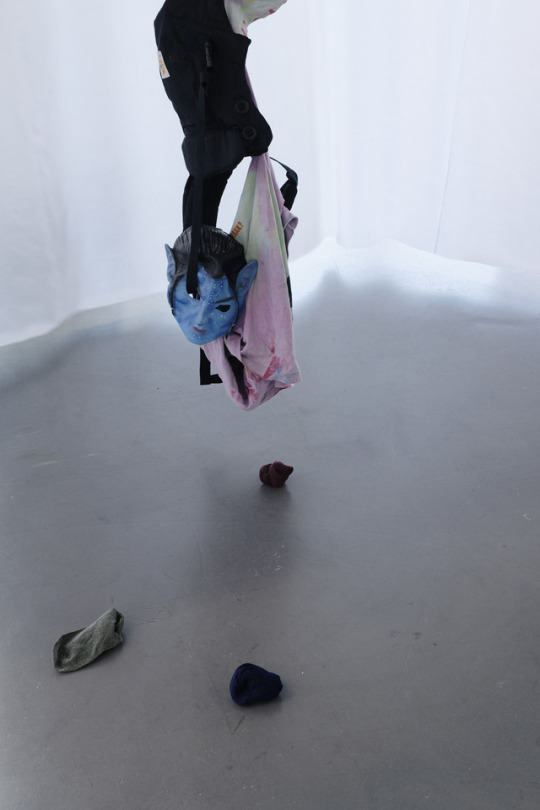
Jean-Alain Corre
Futomomo
at CAC Brétigny, Brétigny-sur-Orge, France
2019
56 notes
·
View notes
Photo
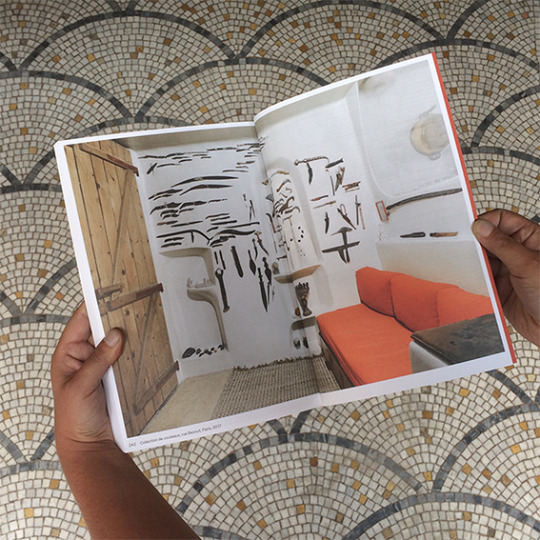
Hélène Bertin, Valentine Schlegel: je dors, je travaille
Publié par <o> future <o> et le CAC Brétigny
Conception éditoriale: Hélène Bertin, Charles Mazé & Coline Sunier
Notices biographiques: Hélène Bertin
Design graphique: Charles Mazé & Coline Sunier
Relecture: Jean-François Caro
Photogravure: Les Artisans du Regard
Impression: Graphius
Diffusion: Les presses du réel
Édition française
18,5 × 27,3 cm, 224 pages
ISBN 978-2-9560078-0-7
4 notes
·
View notes
Photo

Footnotes, Issue C Available at www.draw-down.com Footnotes is the periodical bulletin of applied research in type design, produced by the Swiss digital type foundry La Police. The third issue (Issue C) features: the second part of research series focused on Ladislas Mandel's typefaces for telephone directories (including Linéale, Lusitania & Nordica) as well as text by Coline Sunier & Charles Mazé, who share their work on the visual identity for CAC Brétigny, a project which also produced the typefaces LARA and BALI. Type designer Nicolien van der Keur writes about the production of typewriter type styles and their influence on letterpress typefaces; French designer Alaric Garnier shares the identity he built for the May Gallery in New Orleans, drawing on a sign painting apprenticeship and exploring the efficacies needed to address a shoestring budget; and Dan Reynolds retraces the origins of Akzidenz-Grotesk. The issue also includes a selection of in-progress type projects by the contributors of issue C and its future successor, issue D. #Footnotes #typefaces #AkzidenzGrotesk (at Switzerland) https://www.instagram.com/p/B0inumGHUOL/?igshid=8m9qz4m95iyn
4 notes
·
View notes
Link
0 notes
Text
"Le sujet-supposé-savoir" in Disquiet Junto #0515: Talking Care
acousticmirror
·
Le sujet-supposé-savoir (disquiet0515)
Le sujet-supposé-savoir is my contribution to this week's Disquiet Junto project: #0515 - Talking Cure. The assignment consisted in writing music for a therapist's waiting room. Selected results from this assignment will be included in the soundtrack of an experimental video series The Talking Cure, currently being produced by visual artists The Big Conversation Space. The Talking Cure will be projected in the group exhibition The Real Show at the contemporary art museum CAC Brétigny, France from January through April 2022 and broadcast on YouTube.
When pondering this week’s theme of Talking Care, and the context of a therapist’s waiting room, I was prompted to think about psychoanalysis, Mladen Dolar’s inquiry into the implications of the voice in “The Voice and Nothing More”, and, eventually, to sample the voice of Jacques Lacan.
Mladen Dolar says:
“The voice may well be the key to the presence of the present and to an unalloyed interiority, but it conceals in its bosom that inaudible object voice which disrupts both. (…) This object embodies the very impossibility of attaining auto-affection; it introduces a scission, a rupture in the middle of the full presence, and refers it to a void—but a void which is not simply a lack, an empty space; it is a void in which the voice comes to resonate.”
Original vocal samples are from the first few seconds of this well-known clip of Jacques Lacan giving a lecture:
youtube
More on this 515th weekly Disquiet Junto project — Talking Cure (The Assignment: Write music for a psychotherapist’s waiting room) — at: https://disquiet.com/0515/
More on the Disquiet Junto at: https://disquiet.com/junto/
Subscribe to project announcements here: https://tinyletter.com/disquiet-junto/
Project discussion takes place on llllllll.co: https://llllllll.co/t/disquiet-junto-project-0515-talking-cure/
0 notes
Text
Marseille dans l’art contemporain
Sara Sadik artiste basée à Marseille s’inspire de son passé qu’elle explicite comme une « existence en tant qu’avatars ». Elle se confie sur le fait que les artistes mondialement connus de nos jours répondent chacun au même stéréotype, aussi bien physiquement, que dans leur art.
Notre artiste souhaite déjouer cette assignation en proposant un contenu d’un nouveau type. Réalisant de plus en plus d’exposition, comme une exposition collective à Vancouver en 2017, la Wallach Art Gallery Collumbia University à New York. Elle tente de représenter un art se rapprochant le plus de la culture de la jeunesse maghrébine des quartiers populaire.
Sara s’attache à documenter à travers des fictions et des mises en scènes des analyses sociologiques et sémiologique en collaboration avec des jeunes de Marseille, des clichés et mythologies sociales.
Dans sa nouvelle exposition actuellement au CAC de Brétigny sur orge, elle présente sa « Hlel Academy ». Dans ses œuvres elle explore les rapports, relations, interaction et démonstrations sentimentales et amoureuses chez les adolescents, par le biais du schéma-type de la construction d’un couple massivement partagée.
La « Hlel Academy » est un centre de formation fictif, situé à Marseille, destiné à recueillir des jeunes adolescents ayant vécu des déceptions amoureuses afin de leur offrir une formation leur permettant de se reconstruire émotionnellement.
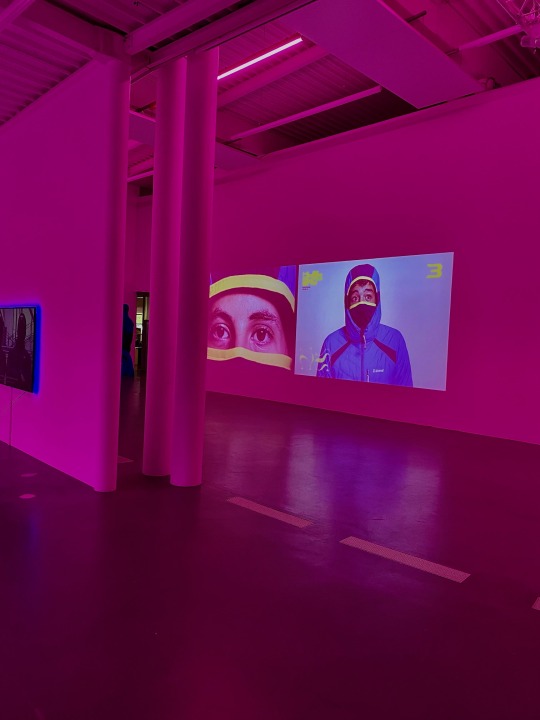
Photographie de l’exposition de Sara Sadik au CAC de Brétigny-sur-Orge.
Les œuvres exposées sont au nombre de 4, toutes des vidéos mettant en scène de jeunes personnes masculines.
La première réalisation étant composée de 2 vidéos s’appelant « RIEN 100 RIEN », elle base sous forme de séance chez le psychologue une interview posant des questions à de jeunes hommes sur la vie en couple.
La deuxième réalisation se nomme « CARNALITO FULL OPTION ». Elle est la seconde étape de l’Académie. Sara reprend le concept de la télé-réalité, dans laquelle 5 adolescents se retrouvent isolés au cœur d’une arène coupé du monde extérieur. Le but, être élu « le gadjo idéal ». Chaque étape étant conçue en s’inspirant du modèle type de l’homme parfait par les adolescents du centre éducatif fermé de Marseille.
Le dernier projet datant de 2021, se nomme « KHTOBTOGONE ». Elle met en scène un homme dans un univers s’inspirant du jeu vidéo GTA, qui tombe fou amoureux de sa « Bulma », et qui doit alors rallier à sa vie de communauté avec ses « frères ». Ce projet s’est vu réalisé a partir de 2 récits de jeunes hommes.
VINIAL MARINE
L2 DROIT, NOV 2021
0 notes
Photo
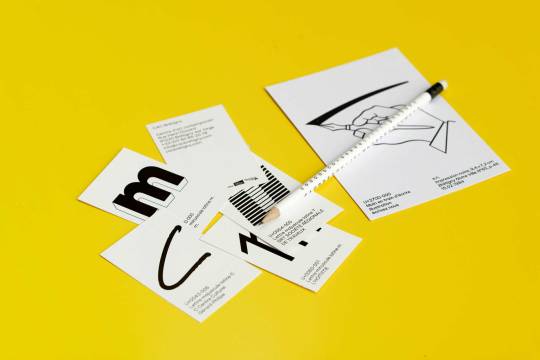
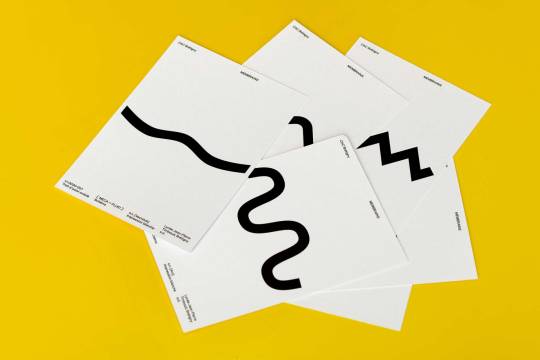


Identité visuelle du CAC Brétigny
Charles Mazé & Coline Sunier
2016
“En résidence au CAC Brétigny, Charles Mazé & Coline Sunier sont en charge de l’identité graphique du centre d’art, conçue comme un espace de recherche sur le long terme.
L'ABCC du CACB est un abécédaire composé de lettres et de signes collectés à Brétigny et dans le département de l'Essonne, ou choisis en relation avec le centre d'art, son programme et ses artistes invités. Ce corpus prend la forme d’une typographie intitulée LARA, dont certains signes sont activés, un par un, sur les supports de communication, considérés comme des espaces de publication et de diffusion de la recherche. En associant des voix multiples dans une même typographie dont le nombre de glyphes est en perpétuelle augmentation, avec des écritures tour à tour vernaculaires, institutionnelles, personnelles ou publiques, L'ABCC du CACB tente d’éditer le contexte géographique, politique et artistique dans lequel se trouve le CAC Brétigny à travers une typologie de signes dessinés.”
https://www.cacbretigny.com/fr/residencies/39-l-abcc-du-cacb
0 notes
Video
vimeo
Aurore 20 min. 2K, 5.1 sound
French with English subtitles
Director, scriptwriter, editor: Marlies Pöschl
Assistant director : Lauren Oliel
DOP Paris: Victor Zébo
DOP Salzburg : David Rabeder
Drone Operator : Daniel Ausweger
Sound engineer: Gaél Eleon
Original music : Peter Kutin
Sounddesign: Florian Kindlinger
Vocal Artist: Agnes Hvizdalek
Produced by Marlies Pöschl
In the framework of "Pixel, Bytes and Film",
ORF III/BKA
In co-production with Bertrand Scalabre,
Hidden Mother, Paris
and CAC Brétigny
Stills
Contact me for full preview
Aurore is a voice without a body, she lives in a crack, resides on the interface. At a retirement home in the south of Paris, she’s engaged to keep people company. Technically though, she can work in many places at once. Wherever Aurore appears, she brings warmth to the dim rooms, a slight glow to people’s eyes, as if taking away the weight of the every day. She’s there for the people, she really cares for the world, twenty-four-seven. Fatigue is foreign to her.
Playing with the aesthetic codes of three genres – documentary, corporate and experimental film – and loosely structured in 3 chapters, “Aurore” investigates the affective dimensions of those genres. This semi-documentary science-fiction about the future of care and the automatization of affect has been developed in the context of a collaborative project that Marlies Pöschl undertook during her artist residency at CAC Brétigny, Paris. All the elements that appear in this film have been created in collaboration with the participants: primary school children, high school students and seniors. The second part of the film is a collaboration between Pöschl, composer Peter Kutin and vocal artist Agnes Hvizdalek. “Aurore” is an attempt to write science-fiction differently: in dialogue, in vernacular.
#vienna biennale#kunsthalle wien#care#technology#artificial intelligence#collaboration#social practice
0 notes